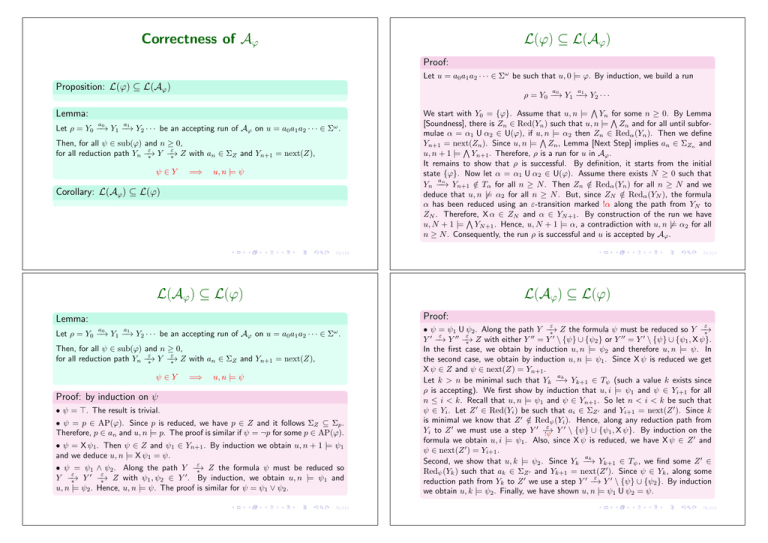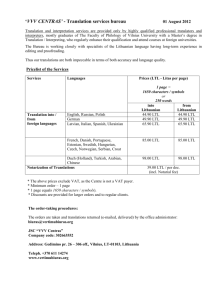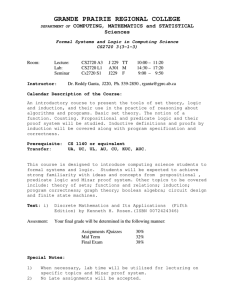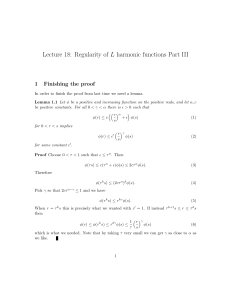Correctness of Aϕ L(ϕ) ⊆ L(A L(Aϕ) ⊆ L(ϕ) L(Aϕ
advertisement

Correctness of Aϕ
L(ϕ) ⊆ L(Aϕ)
Proof:
Let u = a0 a1 a2 · · · ∈ Σω be such that u, 0 |= ϕ. By induction, we build a run
Proposition: L(ϕ) ⊆ L(Aϕ )
a
Lemma:
a
a
0
1
Let ρ = Y0 −→
Y1 −→
Y2 · · · be an accepting run of Aϕ on u = a0 a1 a2 · · · ∈ Σω .
Then, for all ψ ∈ sub(ϕ) and n ≥ 0,
ε
ε
for all reduction path Yn −→
→
∗ Y −
∗ Z with an ∈ ΣZ and Yn+1 = next(Z),
ψ∈Y
=⇒
u, n |= ψ
Corollary: L(Aϕ ) ⊆ L(ϕ)
a
0
1
ρ = Y0 −→
Y1 −→
Y2 · · ·
!
We start with Y0 = {ϕ}. Assume that u, n |= Yn !
for some n ≥ 0. By Lemma
[Soundness], there is Zn ∈ Red(Yn ) such that u, n |= Zn and for all until subformulae α = α1 U α2 ∈ U(ϕ), if u,!n |= α2 then Zn ∈ Redα (Yn ). Then we define
Yn+1 = next(Z
! n ). Since u, n |= Zn , Lemma [Next Step] implies an ∈ ΣZn and
u, n + 1 |= Yn+1 . Therefore, ρ is a run for u in Aϕ .
It remains to show that ρ is successful. By definition, it starts from the initial
state {ϕ}. Now let α = α1 U α2 ∈ U(ϕ). Assume there exists N ≥ 0 such that
an
Yn+1 ∈
/ Tα for all n ≥ N . Then Zn ∈
/ Redα (Yn ) for all n ≥ N and we
Yn −−→
deduce that u, n '|= α2 for all n ≥ N . But, since ZN ∈
/ Redα (YN ), the formula
α has been reduced using an ε-transition marked !α along the path from YN to
ZN . Therefore,
! X α ∈ ZN and α ∈ YN +1 . By construction of the run we have
u, N + 1 |= YN +1 . Hence, u, N + 1 |= α, a contradiction with u, n '|= α2 for all
n ≥ N . Consequently, the run ρ is successful and u is accepted by Aϕ .
73/113
74/113
L(Aϕ) ⊆ L(ϕ)
L(Aϕ) ⊆ L(ϕ)
Proof:
Lemma:
a0
a1
Let ρ = Y0 −→ Y1 −→ Y2 · · · be an accepting run of Aϕ on u = a0 a1 a2 · · · ∈ Σω .
Then, for all ψ ∈ sub(ϕ) and n ≥ 0,
ε
ε
for all reduction path Yn −→
→
∗ Y −
∗ Z with an ∈ ΣZ and Yn+1 = next(Z),
ψ∈Y
=⇒
u, n |= ψ
Proof: by induction on ψ
• ψ = (. The result is trivial.
• ψ = p ∈ AP(ϕ). Since p is reduced, we have p ∈ Z and it follows ΣZ ⊆ Σp .
Therefore, p ∈ an and u, n |= p. The proof is similar if ψ = ¬p for some p ∈ AP(ϕ).
• ψ = X ψ1 . Then ψ ∈ Z and ψ1 ∈ Yn+1 . By induction we obtain u, n + 1 |= ψ1
and we deduce u, n |= X ψ1 = ψ.
ε
• ψ = ψ1 ∧ ψ2 . Along the path Y −→
∗ Z the formula ψ must be reduced so
ε
ε
"
"
Y −→
Y
−
→
Z
with
ψ
,
ψ
∈
Y
.
By induction, we obtain u, n |= ψ1 and
1
2
∗
∗
u, n |= ψ2 . Hence, u, n |= ψ. The proof is similar for ψ = ψ1 ∨ ψ2 .
75/113
ε
ε
• ψ = ψ1 U ψ2 . Along the path Y −→
→
∗ Z the formula ψ must be reduced so Y −
∗
ε
ε
""
"
""
"
Y " −→ Y "" −→
∗ Z with either Y = Y \ {ψ} ∪ {ψ2 } or Y = Y \ {ψ} ∪ {ψ1 , X ψ}.
In the first case, we obtain by induction u, n |= ψ2 and therefore u, n |= ψ. In
the second case, we obtain by induction u, n |= ψ1 . Since X ψ is reduced we get
X ψ ∈ Z and ψ ∈ next(Z) = Yn+1 .
ak
Let k > n be minimal such that Yk −→
Yk+1 ∈ Tψ (such a value k exists since
ρ is accepting). We first show by induction that u, i |= ψ1 and ψ ∈ Yi+1 for all
n ≤ i < k. Recall that u, n |= ψ1 and ψ ∈ Yn+1 . So let n < i < k be such that
ψ ∈ Yi . Let Z " ∈ Red(Yi ) be such that ai ∈ ΣZ ! and Yi+1 = next(Z " ). Since k
is minimal we know that Z " ∈
/ Redψ (Yi ). Hence, along any reduction path from
ε
Y " \ {ψ} ∪ {ψ1 , X ψ}. By induction on the
Yi to Z " we must use a step Y " −!ψ
→
formula we obtain u, i |= ψ1 . Also, since X ψ is reduced, we have X ψ ∈ Z " and
ψ ∈ next(Z " ) = Yi+1 .
ak
Second, we show that u, k |= ψ2 . Since Yk −→
Yk+1 ∈ Tψ , we find some Z " ∈
Redψ (Yk ) such that ak ∈ ΣZ ! and Yk+1 = next(Z " ). Since ψ ∈ Yk , along some
ε
reduction path from Yk to Z " we use a step Y " −→ Y " \ {ψ} ∪ {ψ2 }. By induction
we obtain u, k |= ψ2 . Finally, we have shown u, n |= ψ1 U ψ2 = ψ.
76/113
L(Aϕ) ⊆ L(ϕ)
Example with two until sub-formulae
Example: Nested until: ϕ = p U ψ with ψ = q U r
Red({ϕ}) = {{p, X ϕ}, {q, X ψ}, {r}}
Proof:
ε
ε
• ψ = ψ1 R ψ2 . Along the path Y −→
→
∗ Z the formula ψ must be reduced so Y −
∗
" ε
"" ε
""
"
""
"
Y −→ Y −→
∗ Z with either Y = Y \{ψ}∪{ψ1 , ψ2 } or Y = Y \{ψ}∪{ψ2 , X ψ}.
In the first case, we obtain by induction u, n |= ψ1 and u, n |= ψ2 . Hence, u, n |= ψ
and we are done. In the second case, we obtain by induction u, n |= ψ2 and we get
also ψ ∈ Yn+1 . Continuing with the same reasoning, we deduce easily that either
u, n |= G ψ2 or u, n |= ψ2 U (ψ1 ∧ ψ2 ).
Red({ψ}) = {{q, X ψ}, {r}}
Redϕ ({ϕ}) = {{q, X ψ}, {r}}
Redψ ({ϕ}) = {{p, X ϕ}, {r}}
Redϕ ({ψ}) = {{q, X ψ}, {r}}
Redψ ({ψ}) = {{r}}
ψ
Σq
Σq
ϕ
ϕ = p U (q U r)
Σp
Σr
ψ = qUr
ϕ
Σr
ϕ, ψ
ϕ, ψ
∅
Σ
ϕ, ψ
77/113
78/113
On the fly simplifications Aϕ
Satisfiability and Model Checking
Corollary: PSPACE upper bound for satisfiability and model checking
!
!
Let ϕ ∈ LTL, we can check whether ϕ is satisfiable (or valid)
in space polynomial in |ϕ|.
Let ϕ ∈ LTL and M = (S, T, I, AP, &) be a Kripke structure.
We can check whether M |=∀ ϕ (or M |=∃ ϕ)
in space polynomial in |ϕ| + log |M |.
Built-in: reduction of a maximal formula.
Definition: Additional reduction rules
If
Proof:
Transitions:
∧
Y ≡
!
ε
Y " then we may use Y −
→ Y ".
Remark: checking equivalence is as hard as building the automaton.
Hence we only use syntactic equivalences.
For M |=∀ ϕ we construct a synchronized product M ⊗ A¬ϕ :
s−
→ s" ∈ M
!
&(s)
Y −−→ Y " ∈ A¬ϕ
&(s)
(s, Y ) −−→ (s" , Y " )
Initial states: I × {{¬ϕ}}.
If ψ = ψ1 ∨ ψ2 and ψ1 ∈ Y or ψ2 ∈ Y :
Y
ε
−→
Y \ {ψ}
If ψ = ψ1 U ψ2 and ψ2 ∈ Y :
Y
ε
−→
Y \ {ψ}
If ψ = ψ1 R ψ2 and ψ1 ∈ Y :
Y
−→ Y \ {ψ} ∪ {ψ2 }
ε
Acceptance conditions: inherited from A¬ϕ .
Check M ⊗ A¬ϕ for emptiness.
79/113
80/113
On the fly simplifications Aϕ
Other constructions
Definition: Merging equivalent states
Let A = (Q, Σ, I, T, T1 , . . . , Tn ) and s1 , s2 ∈ Q.
We can merge s1 and s2 if they have the same outgoing transitions:
∀a ∈ Σ, ∀s ∈ Q,
!
(s1 , a, s) ∈ T ⇐⇒ (s2 , a, s) ∈ T
and
(s1 , a, s) ∈ Ti ⇐⇒ (s2 , a, s) ∈ Ti
for all 1 ≤ i ≤ n.
!
Remark: Sufficient condition
Two states Y, Y " of Aϕ have the same outgoing transition if
Red(Y ) = Red(Y " )
!
"
and
for all α ∈ U(ϕ).
Redα (Y ) = Redα (Y )
!
Tableau construction. See for instance [9, Wolper 85]
+ : Easy definition, easy proof of correctness
+ : Works both for future and past modalities
– : Inefficient without optimizations
Using Very Weak Alternating Automata [10, Gastin & Oddoux 01].
+ : Very efficient
– : Only for future modalities
Online tool: http://www.lsv.ens-cachan.fr/~gastin/ltl2ba/
The domain is still very active.
See other references in [6, Demri & Gastin 10].
Example: Let ϕ = G F p ∧ G F q.
Without merging states Aϕ has 4 states.
These 4 states have the same outgoing transitions.
The simplified automaton has only one state.
81/113
MC∃(X, U) ≤P SAT(X, U)
[11, Sistla & Clarke 85]
82/113
QBF Quantified Boolean Formulae
Definition: QBF
Let M = (S, T, I, AP, &) be a Kripke structure and ϕ ∈ LTL(AP, X, U)
Input:
A formula γ = Q1 x1 · · · Qn xn γ " with γ " =
'
#
aij
1≤i≤m 1≤j≤ki
Introduce new atomic propositions: APS = {ats | s ∈ S}
!
Define AP" = AP 4 APS
Σ" = 2AP
π : Σ"ω → Σω by π(a) = a ∩ AP.
Qi ∈ {∀, ∃} and aij ∈ {x1 , ¬x1 , . . . , xn , ¬xn }.
Question: Is γ valid?
Let w ∈ Σ"ω . We have w |= ϕ iff π(w) |= ϕ
"
2
Define ψM ∈ LTL(AP
, X, F)
of size O(|M | ) by
"
$
#
#
#
'
'
'
ats ∧
X att
ψM =
¬p ∧
ats ∧ G
p∧
¬att ∧
s∈I
s∈S
t&=s
p∈&(s)
p∈&(s)
/
t∈T (s)
Let w = a0 a1 a2 · · · ∈ Σ"ω . Then, w |= ψM iff there exists an initial infinite run σ
of M such that π(w) = &(σ) and ai ∩ APS = {atsi } for all i ≥ 0.
Therefore, M |=∃ ϕ
M |=∀ ϕ
iff
iff
ψM ∧ ϕ is satisfiable
ψM ∧ ¬ϕ is not satisfiable
Definition:
An assignment of the variables {x1 , . . . , xn } is a word v = v1 · · · vn ∈ {0, 1}n.
We write v[i] for the prefix of length i.
Let V ⊆ {0, 1}n be a set of assignments.
!
!
V is valid (for γ " ) if v |= γ " for all v ∈ V ,
V is closed (for γ) if ∀v ∈ V , ∀1 ≤ i ≤ n s.t. Qi = ∀,
∃v " ∈ V s.t. v[i − 1] = v " [i − 1] and {vi , vi" } = {0, 1}.
Proposition:
γ is valid
Remark: we also have MC∃ (X, F) ≤P SAT(X, F).
83/113
iff
∃V ⊆ {0, 1}n s.t. V is nonempty valid and closed
84/113
∃
QBF ≤P MC'
(U)#[11, Sistla & Clarke 85]
Let γ = Q1 x1 · · · Qn xn
QBF ≤P MC∃(U) [11, Sistla & Clarke 85]
aij with Qi ∈ {∀, ∃} and aij literals.
1≤i≤m 1≤j≤ki
Consider the KS M :
xt1
e0
s1
xt2
e1
s2
xf1
f0
Let ψij =
*
e2
a21
a12
..
.
a1k1
a22
..
.
a2k2
f1
Let ϕj = G(ej−1 → (¬sj−1 U
Each finite path τ = e0 −
→ fm in M defines a valuation v τ by:
*
1 if τ, |τ | |= ¬sk S xtk
vkτ =
0 if τ, |τ | |= ¬sk S xfk
xfn
am1
···
f2
G(xfk → sk R ¬aij ) if aij = xk
G(xtk → sk R ¬aij ) if aij = ¬xk
xtj )
∗
en
sn
···
xf2
a11
Proof: If M |=∃ ψ ∧ ϕ then γ is valid
xtn
∧ (¬sj−1 U
xfj )
Then, γ is valid iff M |=∃ ψ ∧ ϕ.
fm−1
am2
..
.
amkm
fm
Let σ be an initial infinite path of M s.t. σ, 0 |= ψ ∧ ϕ.
∗
→ fm is a prefix of σ}.
Let V = {v τ | τ = e0 −
Claim: V is nonempty, valid and closed.
and
ψ=
'
ψij .
i,j
and
ϕ=
'
ϕj .
j|Qj =∀
85/113
86/113
QBF ≤P MC∃(U) [11, Sistla & Clarke 85]
Complexity of LTL
Proof: If γ is valid then M |=∃ ψ ∧ ϕ
Let V ⊆ {0, 1}n be nonempty, valid and closed.
First ingredient: extension of a run.
∗
Assume τ = e0 −
→ fm satisfies v τ ∈ V and τ, 0 |= ψ.
Let 1 ≤ i ≤ n with Qi = ∀.
Let v " ∈ V s.t. v " [i − 1] = v[i − 1] and {vi , vi" } = {0, 1}.
!
∗
∗
We can extend τ in τ " = τ −
→ si −
→ en −
→ f0 −
→ fm with v τ = v " and τ " , 0 |= ψ.
"
We say that τ is an extension of τ wrt. i
Second step: the sequence of indices for the extensions.
Let 1 ≤ i& < · · · < i1 ≤ n be the indices of universal quantifications (Qij = ∀).
Define by induction w1 = i1 and if k < &, wk+1 = wk ik+1 wk . Let w = (w& 1)ω .
Theorem: Complexity of LTL
The following problems are PSPACE-complete:
!
!
!
!
SAT(LTL(X, U, Y, S)), MC∀ (LTL(X, U, Y, S)), MC∃ (LTL(X, U, Y, S))
SAT(LTL(X, F)), MC∀ (LTL(X, F)), MC∃ (LTL(X, F))
SAT(LTL(U)), MC∀ (LTL(U)), MC∃ (LTL(U))
The restriction of the above problems to a unique propositional variable
The following problems are NP-complete:
Final step: the infinite run.
∗
→ fm with v τ ∈ V and τ, 0 |= ψ.
Let v ∈ V '= ∅ and let τ = e0 −
We build an infinite run σ by extending τ inductively wrt. the sequence of indices
defined by w.
!
SAT(LTL(F)), MC∃ (LTL(F))
Claim: σ, 0 |= ψ ∧ ϕ.
87/113
88/113





